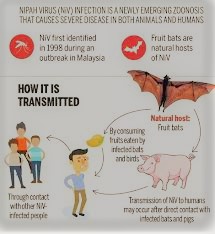what is the Nipah virus?
First identified during a 1999 outbreak of an enigmatic illness affecting humans and pigs in Malaysia, the virus was traced back to fruit bats, the natural hosts. The virus was named after the village where the initial cases were reported. Subsequent outbreaks have been reported in various Asian countries, such as Bangladesh and India. The discovery of this virus has spurred greater attention and research into understanding and containing its transmission. I hope you understand in this article what is Nipah virus.
Transmission and Spread:
The virus is usually spread from animals to humans, through close contact. The primary source of transmission is fruit bats, which are the natural hosts of the virus. Infection can occur through direct contact with infected bats, bodily fluids, or consumption of contaminated food. Additionally, human-to-human transmission can occur through close contact with infected individuals, particularly during the later stages of the illness. To prevent transmission and spread of the Nipah virus, it’s important to practice good hygiene, avoid contact with sick individuals, and handle animals with caution.
Symptoms and Clinical Presentation:
The Nipah virus infection can cause a range of symptoms, including fever, headache, muscle pain, and respiratory problems. Some people may also experience vomiting, sore throat, and dizziness. In severe cases, the infection can progress to encephalitis, which may cause disorientation, seizures, and even coma.
If you experience any of these symptoms, especially if you have had contact with bats or people infected with the Nipah virus, it’s essential to seek medical attention immediately. Early diagnosis and supportive care are critical for managing the clinical presentation of virus infection.
High-Risk Groups and Vulnerable Populations:
Individuals who have had close contact with infected bats or other animals, as well as healthcare workers who treat infected patients, are considered high-risk groups for Nipah virus infection. These groups are more susceptible to contracting the virus and developing severe symptoms, so they must take precautions, such as wearing protective gear and practicing good hygiene, to minimize the risk of infection. If you or someone you know falls into one of these high-risk groups, it’s important to stay informed and follow healthcare professionals’ guidance.
Prevention and Control Measures:
To prevent and control the spread of the Nipah virus, it is crucial to follow good hygiene practices, such as frequently washing your hands with soap and water. It is also important to avoid coming into contact with sick individuals and animals, particularly bats. Additionally, make sure that you cook your food correctly and avoid consuming raw fruits or unpasteurized fruit juices. If you are caring for someone with a Nipah virus infection, use personal protective equipment. Stay informed about the latest public health guidelines and recommendations, and follow them closely. By taking these preventive measures, you can significantly reduce the risk of Nipah virus transmission.
Outbreaks and Global Impact:
Nipah virus outbreaks have mainly occurred in South and Southeast Asia, affecting countries such as Malaysia, Bangladesh, and India. These outbreaks have significantly impacted public health, causing illness and death in humans and animals. The virus is capable of human-to-human transmission, which can lead to larger outbreaks and increased global concern. To detect and respond to Nipah virus cases promptly, countries must have surveillance systems in place. International collaboration and research efforts are ongoing to gain a better understanding of the virus and to control its spread.
Research and Treatment Development:
Ongoing research and treatment development for the Nipah virus are currently underway. A team of scientists and healthcare professionals are working towards gaining a better understanding of the virus, developing diagnostic tests, and exploring potential treatments and vaccines. Due to the global impact of the Nipah virus, international collaboration is essential to address the issue effectively.
Public Health Response and Guidelines:
In response to Nipah virus outbreaks, public health measures are implemented to control the spread of the virus and safeguard the general public. These measures include surveillance and early detection of cases, contact tracing, isolation of infected individuals, and implementing infection prevention and control measures in healthcare facilities. Public health agencies provide healthcare professionals and the public with guidelines and recommendations on how to prevent and manage Nipah virus infections. It is crucial to keep up-to-date with the guidelines provided by local health authorities and adhere to their recommendations to ensure the safety of yourself and others.
Future Concerns and Preparedness Efforts:
It is important to consider the possibility of future Nipah virus outbreaks and to continue to prepare for them accordingly. Governments should strengthen their surveillance systems, improve laboratory capabilities to quickly diagnose cases, and enhance public health infrastructure to manage future outbreaks effectively. Ongoing research and development of treatments and vaccines can help control the impact of the virus. By staying informed and following public health guidelines, we can support global efforts to minimize the impact of the Nipah virus in the future.
I hope this will help you; link 1
another one; link 2

My brother suggested I might like this blog He was totally right This post actually made my day You can not imagine simply how much time I had spent for this info Thanks